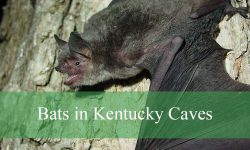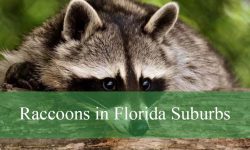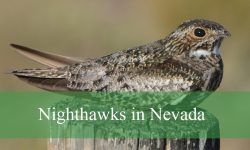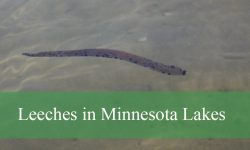Black and white bug species are intriguing subjects in the world of entomology, captivating enthusiasts and researchers alike with their striking coloration and diverse adaptations. These insects, characterized by their distinct black and white patterns, span various families and habitats, each showcasing unique behaviors and ecological roles.
We’ll go into some of the most typical black and white bugs you might run into in this article. We’ll talk about the biology, habitats, and surprising facts about these amazing insects.
Different Types of Black and White Bugs
Banded Alder Borer
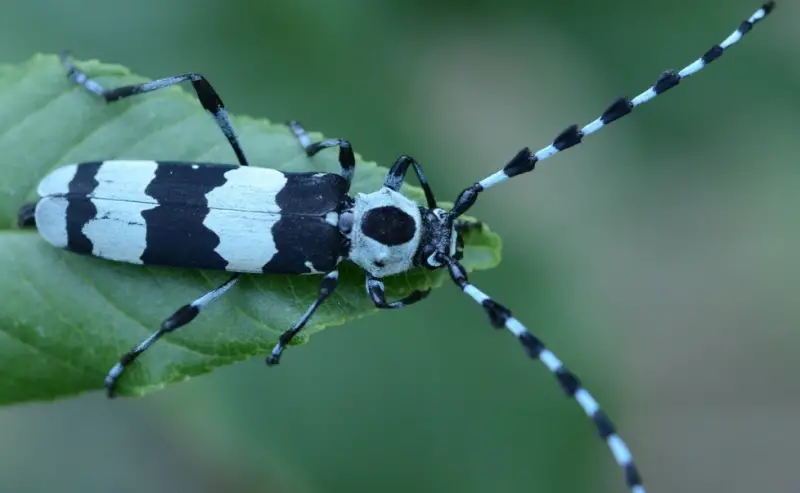
Rosalia funebris, sometimes known as the Banded Alder Borer, is a visually arresting dark beetle with three white bands and a big black mark on its white thorax. It has banded black and white antennae; the females have shorter antennae, while the males have longer antennae than the body. These beetles have slender, elongated bodies and can reach a maximum length of 38 mm.
The Banded Alder Borer is mostly found in western North America, which includes California, Alaska, New Mexico, and Washington. In the spring and summer, it is frequently observed on the bark of alder trees. Additionally, freshly painted structures draw them in. Larvae eat wood, whereas adults eat flowers. They make a characteristic hissing sound, like air escaping from a tube or a squeaking shoe, when they are touched or threatened.
Hairy Rove Beetle
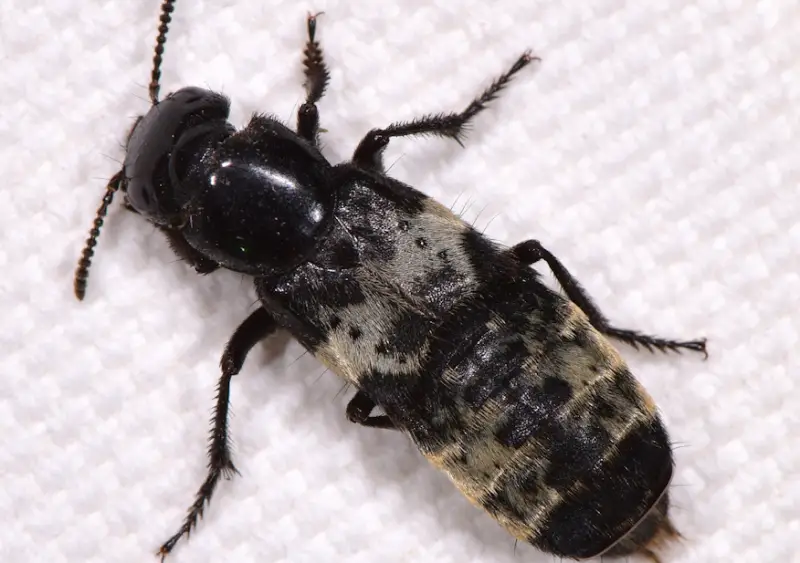
The lustrous, black Hairy Rove Beetle (Creophilus maxillosus) can grow up to 18 mm in length. It has big eyes and crossed mandibles that, if handled, can cause severe agony when bit. Eleven segments make up the robust, beaded antennae.
The eggs laid by this beetle are milky white and hatch after about four days. The pupal stage lasts sixteen days after the fourteen-day larval stage. Hairy Rove Beetles are typically found in wooded areas in the eastern United States. They are active from spring through autumn. They are carnivores who consume corpses and maggots with their curled mandibles. They move quickly, frequently displaying their abdomen like a scorpion’s stinger.
Eight-spotted Flea Beetle

Throughout the Caribbean, Central America, and North America, the Eight-spotted Flea Beetle (Omophoita cyanipennis), a member of the Chrysomelidae family, is frequently encountered. Its thorax is orange, its head is black and white, and it has a black elytra with eight black spots.
These beetles live in a variety of suburban settings, frequently around trees and plants. The reason they are called “flea beetles” is because they can leap away from predators with their strong legs, just like fleas do.
Leconte’s Haploa Moth

The black and white wings of the Leconte’s Haploa Moth (Haploa lecontei) are flat against its body, forming a triangle while it is at rest. Halfway along its length is a conspicuous black midline.
The forewings are bordered with black; some individuals have black vertical stripes or white dots. The black caterpillars with the yellow stripes on their sides and back eat the leaves of different trees and shrubs after the female lays her yellow eggs on the leaves of the host plant. These moths have a maximum size of 50 mm when they are adults.
Buck Moth
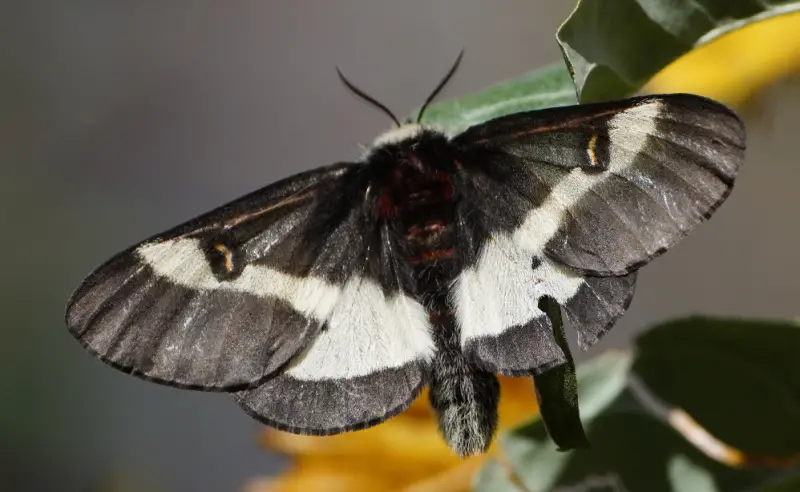
First reported in 1773, the Buck Moth (Hemileuca maia) is a common species in oak woods throughout most of the United States. The larvae have a toxic sac attached to their spiky covering that can burn, sting, itch, and nauseate people. The species is protected as endangered in Connecticut.
Larvae of the buck moth consume a variety of oak species, such as live oak, scrub oak, and white oak. Live oaks are commonly planted as street trees in Louisiana, where these caterpillars can pose a serious hazard.
Polka-Dot Wasp Moth
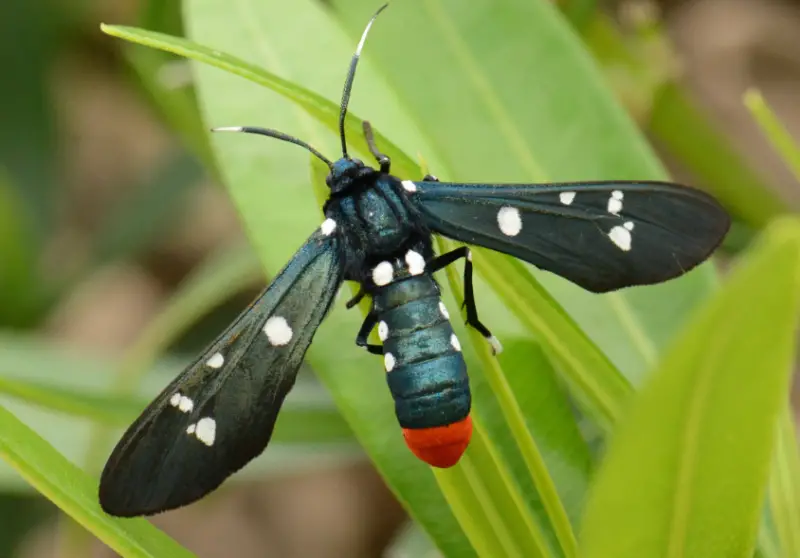
Originating in the Caribbean, the Polka-Dot Wasp Moth (Syntomeida epilais) is a frequent North American pest, especially in Florida and South Carolina, and sometimes sporadically in Texas and Mississippi. These moths are visually remarkable, with a brilliant red tip on the abdomen and a metallic blue body covered in white polka dots. The innocuous moth gets mistaken for a hazardous wasp due to its similar coloring.
They devour oleander plants, which can sustain severe damage, when they are in their caterpillar form. They are orange with dark fur. Additionally, they eat desert rose and devil’s potato plants. They do not cause discomfort, despite their look.
Grape Leaffolder Moth
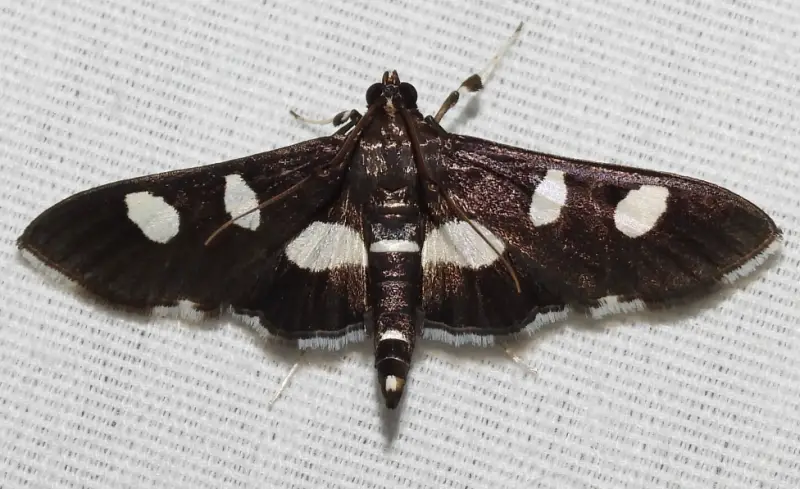
A common species in the southern United States, California, the northeastern states, and southeast Canada is the Grape Leaffolder Moth (Desmia funeralis), a member of the Crambidae family. These moths are diurnal and active from May to September, with a wingspan of up to 28 mm.
In American grapevines, they are regarded as minor pests. The moths are distinguished by a white patch on the underside of their abdomen, and the hind wings of the females have a pitched spot. They can do some harm, which is why their presence is frequently noticed in areas that cultivate grapes.
Peppered Jumping Spider
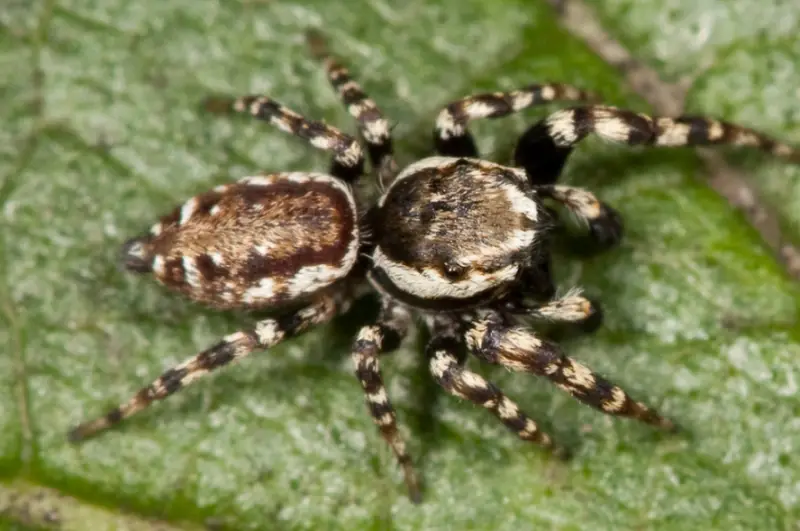
Native to North America, the Peppered Jumping Spider (Pelegrina galathea) prefers sunny, grassy environments. Usually black with white dots, this spider has a mottled gray appearance.
It can jump a great distance in comparison to its size, just like other jumping spiders, and it uses this capacity to elude predators and pursue prey. The Peppered Jumping Spider is not harmful, but if it feels threatened, it can bite. It stands out from other species in its area due to its agility and unique markings.
Garden Fleahopper

Throughout the warmer months, gardens are frequently home to the Garden Fleahopper (Microtechnites bractatus), a plant bug native to the eastern United States and Canada. In thirty days, this pest’s life cycle is finished. Males are slim and grow to a length of 2.1 mm, while females are stockier and grow to a length of 2.2 mm. Adults are shiny black with yellow legs and antennae. When agitated, they are renowned for jumping around.
Garden fleahoppers eat potatoes, pumpkins, squash, tomatoes, and sweet potatoes in addition to their preference for leguminous vegetables, including beets, cabbage, cucumbers, and eggplant. They harm plants by sucking sap from their leaves and stems, which can destroy the plants and leave yellow or white speckles on them.
White-spotted Fruit Chafer
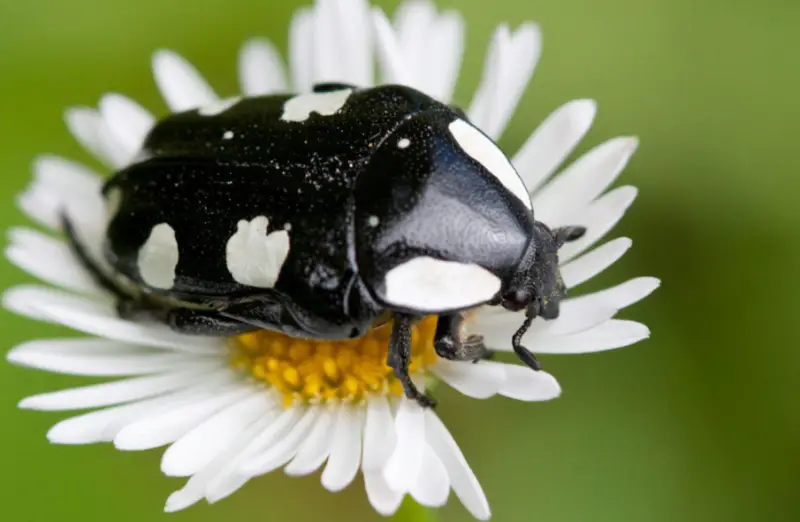
Mausoleums amabilis, also known as the White-spotted Fruit Chafer, is a glossy black insect with characteristic white dots that can be found in a variety of settings throughout Southern Africa. These beetles are drawn to fruit baits, sap flows, and sometimes even bird nests. They are frequently observed in small groups, feeding on garden blossoms.
Their larvae, which resemble C-shaped grubs, grow in the excrement of horses and goats. This beetle stands out in its surroundings due to its preference for a variety of food sources and breeding locations.
Marbled White

Within the Nymphalidae family, the Marbled White (Melanargia galathea) butterfly can be found throughout Europe, Southern Russia, Asia, and Iran. It often inhabits clearings, meadows, and the edges of forests. In the latter part of the 20th century, it significantly increased its range in the United Kingdom.
The Marbled White is a medium-sized butterfly with up to 56 mm of wingspan. Its wings are black or dark brown with white patterns on them. The wings’ undersides are either brown or light gray. Caterpillars are green or yellow in color, with a light brown head and dark longitudinal lines that measure up to 28 mm in length.
Six-spot Ground Beetle
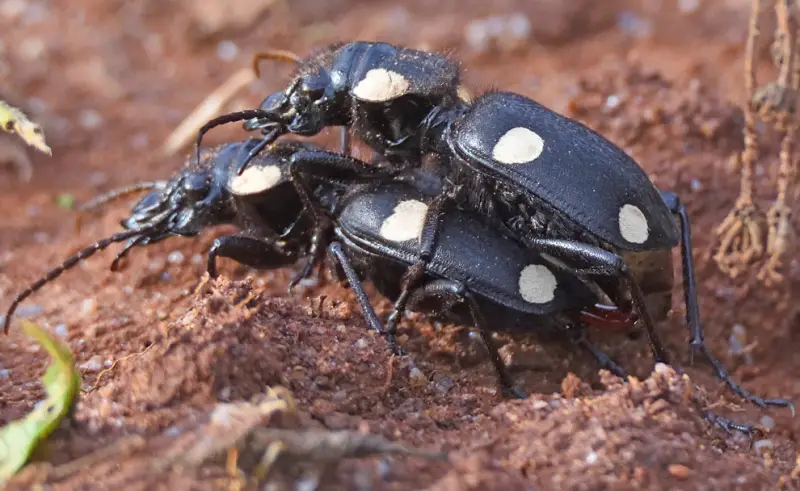
The unique black body of the Six-spot Ground Beetle (Anthia sexguttata) is adorned with six huge white spots, two on the thorax and four on the elytra. The beetle can grow up to 4 cm in size. They have a big head and protruding mandibles when they are flat larvae.
This beetle is typically found in India’s scrub woodlands and dry regions throughout South Asia. Adults contribute to the management of pest populations in their habitat by consuming mostly snails and other insects for food.
Spotted Lanternfly
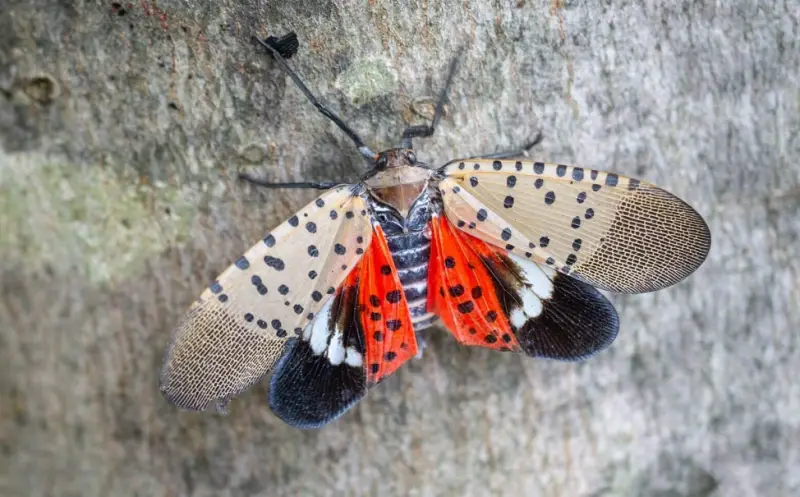
Originating in China, the Spotted Lanternfly (Lycorma delicatula) has spread to South Korea, Japan, and the United States. Its main food sources are the Chinese tree of heaven (Ailanthus altissima), stone fruits, and grapes.
In areas where it has invaded, the Spotted Lanternfly, which is naturally controlled by parasitic wasps, can seriously harm crops and ornamental plants. Nymphs in their early stages are black with white markings; as they mature, they turn red. Adults were brought to South Korea in 2006, Japan in 2009, and the US in 2014. They are distinguished by their black heads and gray wings, with red underwings hidden.
Eastern Eyed Click Beetle
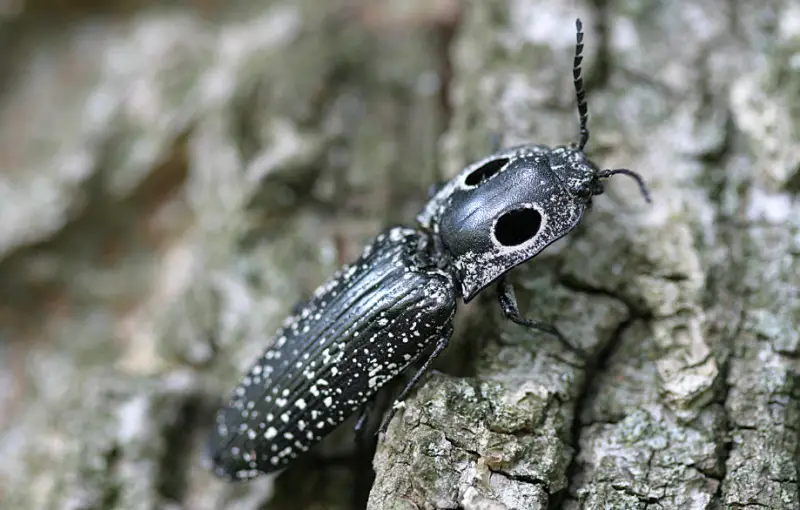
The Eastern-eyed Click Beetle (Alaus oculatus) has a distinctly elongated body and can grow as long as 45 mm. Its big, oval patch of dark scales with a white border stands out against its black skin. This beetle is well-known for its amazing defense system, which entails using its click mechanism to release stored energy and propel itself away from danger.
While the ravenous larvae feed on wood-boring beetle grubs, consuming nearly two hundred of them apiece, the adults mostly eat plant juice and nectar. They are widespread in North and Central America and do well in wooded and forested environments.
Texas Eyed Click Beetle
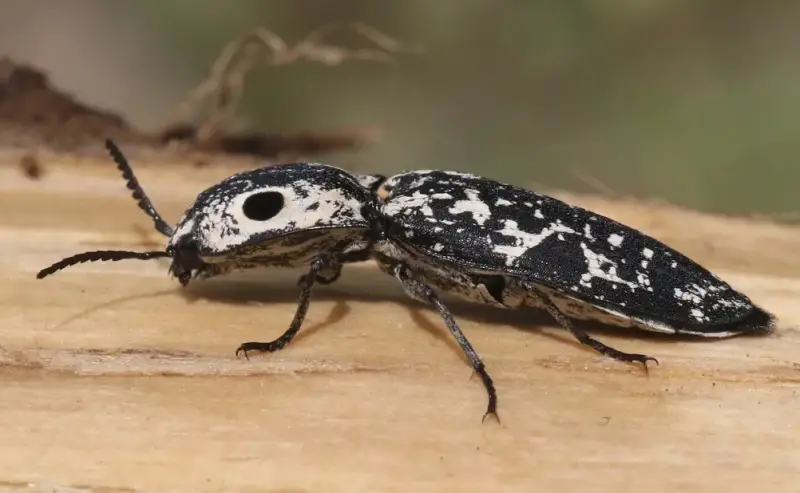
Alaus lusciosus, often known as the Texas Eyed Click Beetle, is a long, flattened beetle with a structure like a shield behind its head. It is up to two inches long, black, and has gray wings and oval eye patches on the pronotum. These beetles have a unique clicking mechanism that allows them to flip onto their backs and right themselves by snapping their thoracic segments.
The hard-bodied larvae, referred to as wireworms, undergo color changes as they develop. Adults, who are often unremarkable, utilize their click to frighten off predators and escape harm. They are naturally nocturnal, drawn to artificial light, and nectar-feeding; they do not pose a threat to people.
Ocellated Tiger Beetle

The Ocellated Tiger Beetle (Cicindela ocellata) grows up to half an inch and is easily recognized by its long legs, antennae, and wide head compared to its thorax. Its coloration varies from black or gray-brown to metallic hues like bronze, green, and blue, adorned with white spots and markings on the wing covers. The beetle’s head and face are covered in fine hairs.
During winter, the beetle hibernates in deep soil burrows, and eggs are laid in single burrows. The larvae also dig burrows, which can extend over a foot deep in hard-packed sand. Commonly found on sunny days in sandy areas along river and stream banks, Ocellated Tiger Beetles tend to flee when approached but may bite if handled roughly.
Tumbling Ragdoll
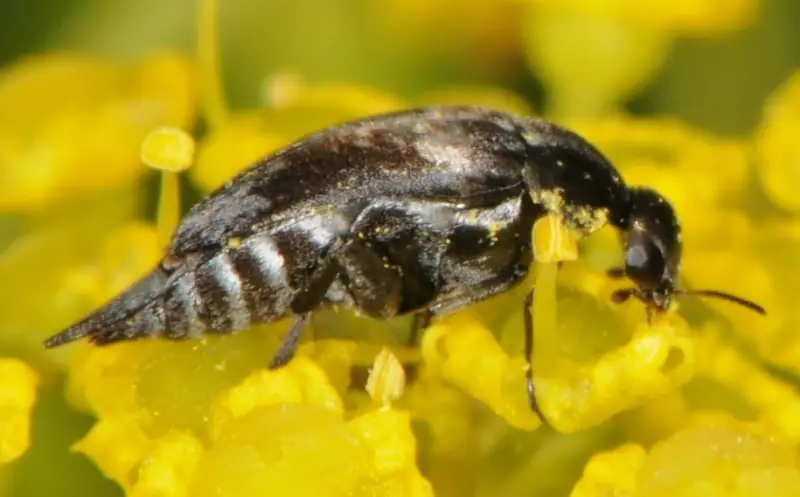
Often referred to as the tumbling flower beetle, the Tumbling Ragdoll (Mordella marginata) is one of about 1,500 different species that make up this complex group. When agitated, these beetles exhibit a unique activity that involves jumping, tumbling, and turning. They are typically found on flowers and are up to 7 mm long. They are black in color.
The wedge-shaped, humpbacked Tumbling Ragdoll has a tapering abdomen and a finely haired body. In their floral surroundings, they provide an intriguing subject of research due to their unusual look and unpredictable motions.
Mormidea v-luteum
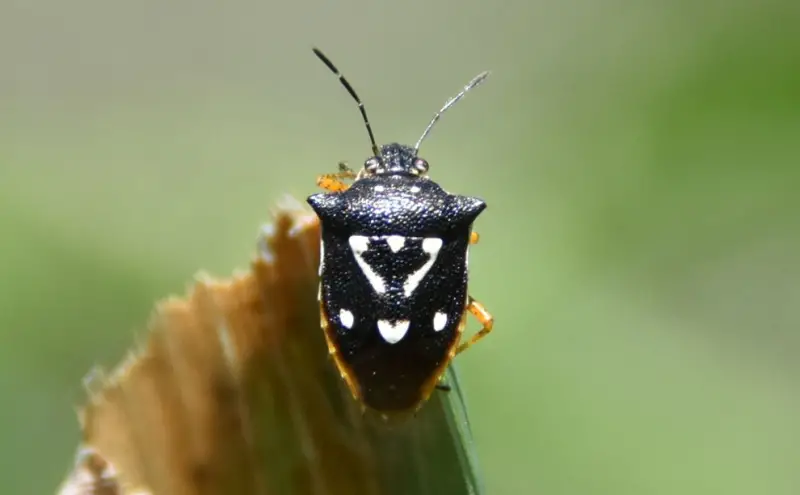
Mormidea v-luteum, first described in 1796, is a significant pest in rice and ryegrass crops. With hundreds of recorded observations, this plant bug poses a serious threat by causing damage that hampers crop growth and reduces productivity.
The Mormidea v-luteum is characterized by its black body with white spots and brown legs and underside. It has a hard exoskeleton, which contributes to its resilience. Due to its impact on vital crops, it is considered a major agricultural concern, particularly affecting rice and ryegrass fields.
Arhaphe arguta
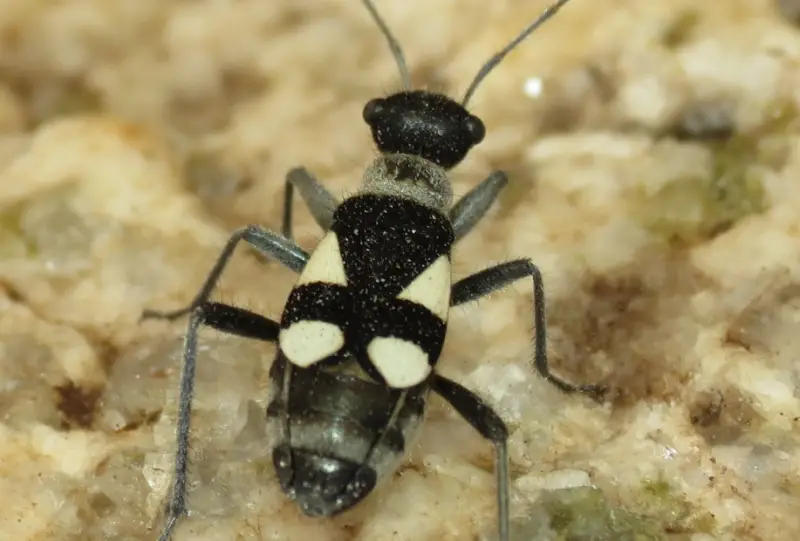
Arhaphe arguta, a member of the Largidae family, is one of the twenty-six described species in this group. These small plant bugs are known for their distinctive noise, produced by rubbing their forewings against their coastal margin.
Arhaphe arguta is commonly found across the United States, including southern and central regions of America, It is a notable presence in various habitats. Their unique sound-making behavior and widespread distribution make them an interesting subject for observation and study.


